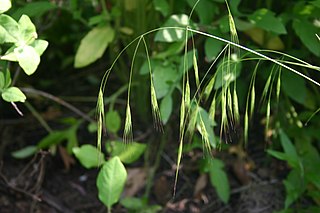
Photodermatitis, sometimes referred to as sun poisoning or photoallergy, is a form of allergic contact dermatitis in which the allergen must be activated by light to sensitize the allergic response, and to cause a rash or other systemic effects on subsequent exposure. The second and subsequent exposures produce photoallergic skin conditions which are often eczematous. It is distinct from sunburn.

Murraya is a genus of flowering plants in the citrus family, Rutaceae. It is distributed in Asia, Australia, and the Pacific Islands. The center of diversity is in southern China and Southeast Asia. When broadly circumscribed, the genus has about 17 species. A narrower circumscription contains only eight species, others being placed in Bergera and Merrillia.

Dictamnus albus is a species of flowering plant in the family Rutaceae. It is also known as burning bush, dittany, gas plant or fraxinella. This herbaceous perennial has several geographical variants. It is native to warm, open woodland habitats in southern Europe, north Africa and much of Asia.

Origanum dictamnus, the dittany of Crete, Cretan dittany or hop marjoram, is a tender perennial plant that grows 20–30 cm high. It is known in Greek as δίκταμο or in the Cretan dialect as έρωντας. It is a therapeutic and aromatic plant that grows wild only on the mountainsides and gorges of the Greek island of Crete. It is widely used for food flavouring and medicinal purposes, in addition to featuring as an ornamental plant in gardens. This small, lanate shrub is easily recognised by the distinctive soft, woolly covering of white-grey hair on its stems and round green leaves, giving it a velvety texture. Its tiny rose-pink flowers are surrounded by brighter purple-pink bracts in summer and autumn. The dittany is classified as vulnerable on the IUCN Red List of Threatened Plant Species 1997.

Origanum is a genus of herbaceous perennial flowering plants and subshrubs in the family Lamiaceae. They are native to Europe, North Africa, and much of temperate Asia, where they are found in open or mountainous habitats. A few species also naturalized in scattered locations in North America and other regions.

Schisandra chinensis, whose fruit is called magnolia berry or five-flavor fruit, is a vine plant native to forests of Northern China, the Russian Far East and Korea. Wild varieties are also found in Japan. It is hardy in USDA Zone 4. The fruits are red berries in dense clusters around 10 centimetres (3.9 in) long.

Nikolai Stepanovich Turczaninow was a Russian botanist and plant collector who first identified several genera, and many species, of plants.

Thryptomene is a genus of flowering plants in the family Myrtaceae and is endemic to Australia. Plants in the genus Thryptomene are shrubs with small leaves arranged in opposite pairs and white or pink flowers. About forty-seven species of Thryptomene, occurring in all Australian states and the Northern Territory, have been formally described.

Bossiaea is a genus of about 78 species of flowering plants in the pea family Fabaceae and is endemic to Australia. Plants in this genus often have stems and branches modified as cladodes, simple, often much reduced leaves, flowers with the upper two sepal lobes larger than the lower three, usually orange to yellow petals with reddish markings, and the fruit a more or less flattened pod.

Amyris is a genus of flowering plants in the citrus family, Rutaceae. The generic name is derived from the Greek word αμυρων, which means "intensely scented" and refers to the strong odor of the resin. Members of the genus are commonly known as torchwoods because of their highly flammable wood.

Butomus is the only known genus in the plant family Butomaceae, native to Europe and Asia. It is considered invasive in some parts of the United States.
Dictamnus is a genus of flowering plant in the family Rutaceae, native to temperate Eurasia from Spain to China. The genus was first described by Carl Linnaeus in 1753.

Schizachne is a genus of Eurasian and North American plants in the grass family. The only accepted species is Schizachne purpurascens, commonly called false melic. Three subspecies are recognized:

Saposhnikovia is a monotypic genus of flowering plants in the family Apiaceae. Its only species is Saposhnikovia divaricata, known as fángfēng防風 in Chinese, bangpung in Korean, and siler in English. The plant is still frequently referenced under the obsolete genus name Ledebouriella in many online sources devoted to traditional Chinese medicine. It was first described as Stenocoelium divaricatum by Nikolai Turczaninow in 1844, and transferred to Saposhnikovia in 1951.

Kadenia is a genus of flowering plants belonging to the family Apiaceae.

Phlojodicarpus is a genus of flowering plants belonging to the family Apiaceae.

Zanthoxyloideae is a subfamily of the family Rutaceae.

Bergera is a genus of flowering plants in the family Rutaceae. It has been included in Murraya as M. sect. Bergera. Species that may be placed in the genus are native from India through southeast Asia eastwards to China and Taiwan southwards to Malesia and New Caledonia. The curry tree, Bergera koenigii, is one of the better known species.
Hansenia is a genus of flowering plant in the family Apiaceae, native to from Siberia to China. The genus was first described by Nikolai Turczaninow in 1844.
















